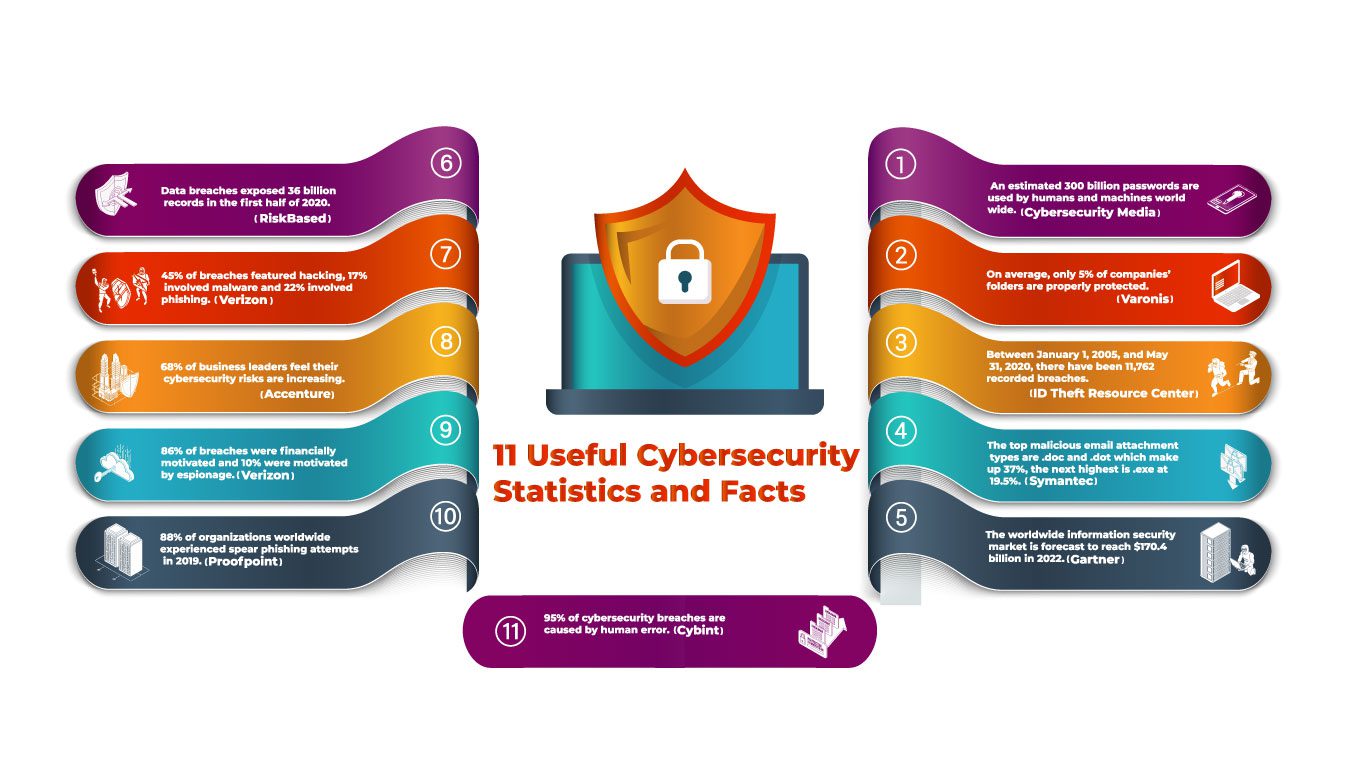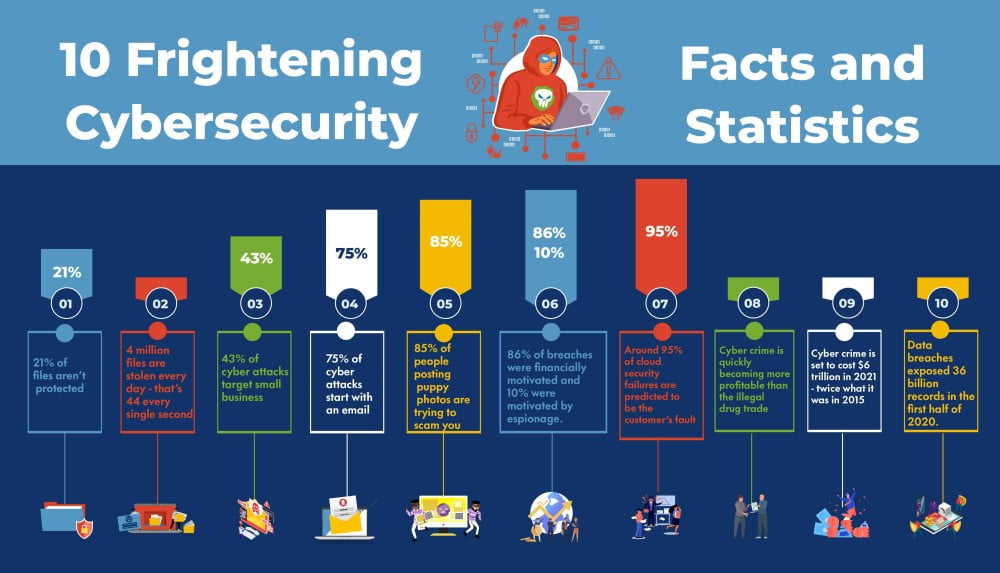Cybersecurity, once a niche concern, has become a top priority for individuals and organizations alike. As we venture into 2024, understanding the latest cybersecurity statistics and trends and is crucial.
Table of Contents
Important Trends To Watch in 2024
The Rise of Privacy Regulation: Gartner predicts that modern privacy regulations like GDPR and CCPA will continue to expand their reach, encompassing a majority of consumer data by the end of 2024.
Human-Centric Approach to Cybersecurity: Gartner anticipates that half of all Chief Information Security Officers (CISOs) will incorporate human-centric design principles into their cybersecurity strategies by 2027.
Challenges of Cyber Risk Quantification: Gartner forecasts that by 2025, 50% of cybersecurity leaders will have attempted but failed to effectively quantify cyber risks.
Work-Related Stressors and Cybersecurity Leadership Transition: According to Gartner, approximately half of all cybersecurity leaders will transition into new roles by 2025, with a significant portion shifting entirely into different fields.
Increased Importance of Cybersecurity Expertise on Boards: Gartner predicts that by 2026, 70% of boards will include at least one member with cybersecurity expertise.
Emerging Role of Threat Detection, Investigation, and Response (TDIR) Capabilities: Gartner forecasts that by 2026, more than 60% of TDIR capabilities will utilize exposure management data to prioritize detected threats.
Adoption of Zero-Trust Programs: Gartner predicts that by 2026, 10% of large organizations will have a mature, widely deployed zero-trust program in place.
Shift in CISO Role from Control Owner to Facilitator: Gartner anticipates that by 2027, 75% of employees will acquire, modify, or create technology beyond the purview of IT departments.
AI and IoT Vulnerabilities: While not explicitly addressed in Gartner’s predictions, the increasing use of Artificial Intelligence (AI) and the proliferation of Internet of Things (IoT) devices introduce new security challenges.
10 Eye-Opening Cybersecurity Statistics for 2024
- Global cybercrime costs are predicted to reach a staggering $9.5 trillion in 2024, a 15% increase from 2023. (Source: Cybersecurity Ventures)
- 85% of cybersecurity professionals believe the use of generative AI by attackers will lead to more sophisticated and undetectable phishing attacks. (Source: Cobalt.io)
- 62% of phishing attacks in 2023 used spear phishing attachments, highlighting the growing threat of supply chain attacks. (Source: IBM Security X-Force)
- 94% of malware is delivered via email, making businesses prime targets for cyberattacks. (Source: Panda Security)
- 95% of security breaches are caused by human error, emphasizing the importance of cybersecurity awareness training. (Source: Specops Software)
- The global cybersecurity market is expected to reach $266 billion by 2025, reflecting the increasing demand for security solutions. (Source: Exploding Topics)
- 80% of organizations plan to adopt AI-powered security solutions by 2024, recognizing AI’s potential in threat detection and prevention. (Source: Crowdstrike)
- The shift to remote work has expanded the attack surface, with 70% of office workers using work devices for personal tasks, potentially introducing security vulnerabilities. (Source: NinjaOne)
- The global cybersecurity workforce is facing a significant skills gap, with an estimated 3.5 million unfilled positions by 2025. (Source: Cybersecurity Ventures)
- Cybersecurity insurance is becoming increasingly popular, with 60% of organizations** expected to have cyber insurance by 2025. (Source: Varonis)
Key Trends To Shape Cybersecurity in 2024
- Tightening Cyber Insurance Requirements
- Harvesting Encrypted Data for Future Decryption
- AI-Powered Attacks for Targeted Phishing and Password Exploits
- Security Fatigue and the Path to Zero Trust
- Global Expansion of Phishing Attacks
Source: Netwrix
11 Useful Cybersecurity Statistics and Facts

- Over 300 billion passwords are being used by humans and machines all over the world. (Cybersecurity Media)
- Only an average of 5% of companies’ folders are properly protected from cyber attacks. (Varonis)
- Between 2005-2020, there have been 11,762 major security breaches. (ID Theft Resource Center)
- .doc and .dot are the top malicious email attachment types which make up 37% and with 19.5%, .exe file type comes second (Symantec)
- The information security market is estimated to reach $170.4 billion by 2022. (Gartner)
- 36 billion data breaches have been recorded in the first half of 2020. (RiskBased)
- Hacking featured 45% of the total breaches, while 17% involved malware attacks and 22% involved phishing attacks. (Verizon)
- Cybersecurity risks are increasing day by day, feels 68% of the business leaders (Accenture)
- 86% of the breaches were financially driven while 10% were motivated by espionage. (Verizon)
- 88% of companies around the world experienced spear-phishing attempts in 2019. (Proofpoint)
- Human errors caused 95% of the total cybersecurity breaches. (Cybintsolutions)
14 Alarming Cybersecurity Statistics That You Must Know
The compilation of the latest security trends & statistics by Cybertalk

1. Cryptocurrency crime is predicted to surpass $30 billion by 2025. (Cybersecurity Ventures)
2. There will be one ransomware attack every 11 seconds by 2022. (Cybersecurity Ventures)
3. The healthcare industry has seen a 51% increase in breaches in the last three years. (Herjavec Group)
4. Software supply chain attacks have increased by 650% in 2021. (VentureBeat)
5. In 93% of cases, cybercriminals can penetrate an organization’s networks. (Positive Technologies)
6. Over 84% of all cyberattacks were distributed via e-mail in 2021. (Checkpoint)
7. By 2021, organizations experienced the highest average cost of a data breach in 17 years at $4.24 million. (IBM)
8. The infamous .exe file type is making up 52% of all malicious files. (Checkpoint)
9. In a recent phishing attack, $7 million in NFTs were stolen from OpenSea users. (The Verge)
10. Cyberattacks are up 50% in 2021 largely due to Log4j exploitations (Checkpoint)
11. 43% of all cyber-attacks are aimed at small businesses. (Accenture)
12. Corporate networks experienced 31% of all cyberattacks in the form of Botnets. (Checkpoint)
13. Trickbot malware is making up 11% of all corporate network attacks globally. (Malwarebytes)
14. With an average of 1,605 weekly cyberattacks, Education and Research organizations were the most targeted sectors. (Checkpoint)
10 Frightening Cyber Security Facts and Statistics

- 21% of files aren’t protected
- 4 million files are stolen every day – that’s 44 every single second
- 43% of cyber attacks target small business
- 75% of cyber attacks start with an email
- 85% of people posting puppy photos are trying to scam you
- 86% of breaches were financially motivated and 10% were motivated by espionage.
- Around 95% of cloud security failures are predicted to be the customer’s fault
- Cybercrime is quickly becoming more profitable than the illegal drug trade
- Cybercrime is set to cost $6 trillion in 2021 – twice what it was in 2015
- Data breaches exposed 36 billion records in the first half of 2020.
10 Disturbing Cyber Security Statistics and Facts

- Email is the primary entry point for 94% of malware attacks
- Every 39 seconds there is a cyber attack
- Human error accounts for 95% of all data breaches
- Most companies take nearly 6 months to detect a data breach, even major ones
- On average, only 5% of companies’ folders are properly protected.
- Since COVID-19 and the increase in staff working from home, the FBI has reported an increase of 300% in reported cybercrimes
- The global average cost of a data breach is $3.9 million across SMEs
- The Netherlands has the lowest cyber crime rate, whilst Russia has the highest
- The worldwide information security market is forecast to reach $170.4 billion in 2022.
- Word, Powerpoint and Excel (the Microsoft Office formats) comprise the most prevalent group of malicious file extensions
What are the Statistics of Cybersecurity?
1. Global Artificial Intelligence in Cybersecurity Market is poised to grow from $16.56 billion in 2022 to $94.3 billion by 2030, at a CAGR of 24.42% during the period of 2023-2030.
2. As per Precedence Research, the global automotive cybersecurity market size is expected to grow from $ 3.1 billion in 2022 to $16.43 billion in 2032.
3. According to the International Cybersecurity Membership Organization (ISC)2, women make up 24% of the cybersecurity total workforce.

